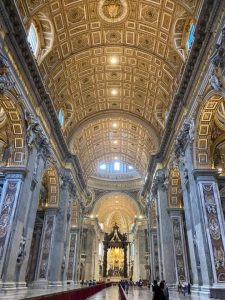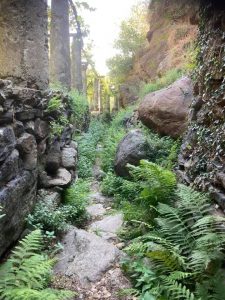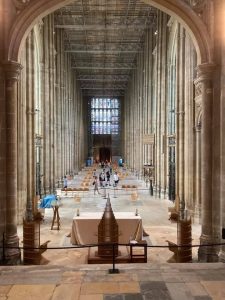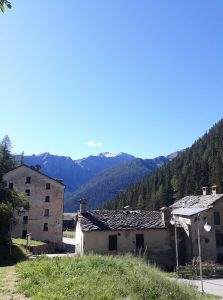
Vineyards in the Champagne region of France near Reims, and a very typical view of us walking the long open road in France
In early August of last year, two friends and I departed from Canterbury Cathedral in Kent, starting a 2,000km journey to the tomb of the apostle Peter in Rome. The UK government had just lifted travel restrictions to the European Union and we had long been craving an adventure, quickly working out that if we walked over 30km every day we could make it to the eternal city before our postgraduate degrees started in October. Inspired by the likes of Saint Benoît-Joseph-Labre, Patrick Leigh Fermor and Jack Kerouac, we had little concern for comforts or luxuries and roughed the whole thing in a tent, usually at the side of the road or in a forest (although after a few encounters with wild boars we soon learned to keep clear of the latter!). We chose to follow the ancient ‘Via Francigena’, in the footsteps of the Archbishop Sigeric of Canterbury, who walked the route to collect his pallium from Rome in 990 AD.
The ancient path took us across endless turnip fields in 40°C heat, under the Gothic facades of imposing medieval cathedrals, across cypress-covered trackways and cobbled Roman roads, over snow-covered mountains at the very top of the Alps and back down along the mighty rivers which carve up the Aosta valley, flow beneath the rolling hills of Tuscany and through the ancient forests of Lazio. After eight long weeks, we reached the Holy See under cover of night, in torrential rain, and collapsed at the foot of St. Peter’s Basilica.
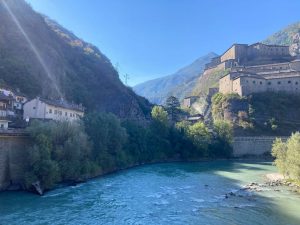
The Fort of Bard above the Fiume Dora Baltea in the Aosta Valley, and a photo of a usual evening of us chatting, reading and drinking very cheap wine by the tent.
It was a truly unforgettable adventure, as spiritually rewarding as it was physically and mentally challenging. In the evenings, we read scripture, poetry, and philosophy to each other, talked about art, life, faith and everything under the sun. In the daytime we would walk, endlessly and in silence, so often reaching that meditative transcendence which comes with intense contemplation, physical effort and concentrated asceticism. More profound than anything, however, was the immense kindness and hospitality we received from people along the way, the countless new faces who quickly became friends, and the generous support and words of encouragement which so many strangers provided. We all left Rome with a renewed optimism about the strength of our common human spirit of love, that connection we all feel which transcends place, faith and culture, and is all the more important to remember at a time when a virus is forcing us physically apart.
I therefore feel incredibly blessed and extremely lucky to have been able to have such an important cultural experience at all, and am hugely grateful for the Beads on One String Foundation for helping to make it possible. Pilgrimages are enriching experiences which everyone should have the opportunity to explore, regardless of faith or background. Indeed, my time walking across Europe allowed me to think a little about the meaning and significance of a pilgrimage and its relation to life, spirituality and prayer, a problem which I understand also interests those at Beads on One String.
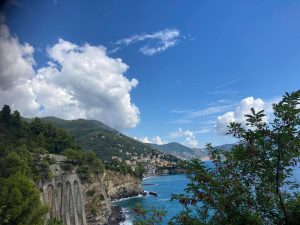
A typical scene in rural Tuscany, and a similar snapshot of the Italian coastline, somewhere
between Genoa and La Spezia.
St. Ignatius of Loyola, the Basque theologian who founded the Jesuit order, saw life itself as a pilgrimage. He frequently explained his Exercitia Spiritualia and general ascetic philosophy as a way of inviting ourselves on a metaphorical pilgrimage towards divine illumination. For example, he tells us that ‘we are pilgrims until we arrive at our heavenly homeland, and we must not let our affections delay us in the roadside inns and lands through which we pass, otherwise we will forget our destination and lose interest in our final goal’. Ignatius means this both literally and metaphorically, as advice for a physical journey and for how best to make use of one’s time on
Earth. He is suggesting that the ultimate aim of ascetic contemplation is that it allows us to make ‘pilgrimage’ to the heavenly city of God, rather to any physical place such as St. Peter’s tomb in Rome.
The Orthodox Christian tradition sheds much light on this difference between pilgrimage as a physical act and as internal prayer, and we all found much inspiration in reading aloud the Philokalia, a collection of mystic texts written by Christian monks and ascetics between the fourth and fifteenth centuries. The authors’ primary lesson is that in interior prayer, ‘the nature of things is judged by the inward disposition of the soul’, and not by its relationship to externalities in the world. Thus, no matter what you are doing, as long as your soul and heart is properly committed to prayer, to the act of worship, then you are on the right track. In this sense, I would say that contemplation and pilgrimage are two different but complementary methods of achieving the ultimate goal of interior prayer and inner connection with God.
However, I would add that in exerting physical effort through walking, and hence by subserving and devoting one’s body to the service of prayer, one more easily achieves what Niketas Stethatos refers to in the Philokalia as the ‘purification of the intellect’ – which I think is necessary for your soul and heart to remain ‘properly committed’ to prayer at all. When walking and praying in silence the mind is at first so often moved to many distractions; life, work, philosophy, politics, sex, money and all the rest of our daily interests, passions, troubles and worries. But as we walked further and further, walking well above 30km a day, this faculty quickly became exhausted and we became first aware only of the constant pain and ever-growing fatigue, and then often of nothing at all, so drained were we of the mental strain of our minds. It was in this state in which deep and meditative prayer was most easily and fruitfully achieved, and we all experienced a certain inner joy and peace in connecting with God in this almost ‘thoughtless’ state (which we described as ‘transcendence’).
Hence, I am not surprised that Stethatos describes the intellect as always already ‘passion-ridden’, in that it is inherently and inevitably subject to imperfections and distractions. Interior prayer is therefore not to be achieved by intellectual comprehension and contemplation of God, but conversely through the purification of the intellect and its replacement with the ‘indwelling presence of the divine Logos’. Similarly, Evagrios Ponticus contends that ‘prayer is the laying aside of thoughts’, and hence that the higher faculties of the mind, our conceptual and analytical dispositions, are not where divine illumination, union with God or the spiritual energisation of the soul through grace is to be found. Rather, on the contrary, it is found in the opening of the heart through calling on Christ’s name in repetition, in a thoughtless and ever-present silence, and in meditative transcendence of base wants and needs. In this way, interior prayer has much in common with the practice of Dhyana in Buddhism. For example, in the Yogacara school of Mahayana Buddhism, intellectual reasoning is only the sixth of eight levels of ascending consciousness, the ultimate aim of which is to go ‘beyond’ reasoning itself.
That prayer should be ‘passive’ and ’empty’ in this way (or in Buddhist terms, achieve ‘Sunyata’, or ‘Anatman’) rather than active, conceptual and intellectually engaged, was made abundantly clear by the inner peace and joy we received in walking our minds into oblivion and reaching
that deep and intense meditative contemplation of God. I think this can be equally achieved walking 35km up a mountain as it can sitting at home, in Church, on a spiritual retreat or in a monastery, but certainly for my ever-wandering mind the aid of physical effort through pilgrimage helped in this process immensely.
Of course, a pilgrimage also comes with a profound historical, cultural and aesthetic significance which in many ways adds to its symbolic, devotional and spiritual value. Although when considered from a strictly spiritual point of view, as many of the Church Fathers and I think most Buddhists would tell you, those are ‘externalities’, and as such only relevant to the inward disposition of the soul in that they might help guide it ever further inwards. I believe that there is much to be said for this understanding of spirituality as something inner and personal rather than outer, external and sacramental, especially when thinking about how to discuss the universal significance of religious rituals like pilgrimages in a multifaith world such as our own. Supposing the latter view of spirituality, that it could be analysed by its manifestation in Church, ritual and liturgy, Emile Durkheim famously highlighted the role of the sacred as a symbol of collective unity, preserving and consolidating the bonds that hold society together in a shared spiritual reality. But pilgrimage is not just a static representation of social identity; Simon Coleman and John Elsner have called pilgrimage an ‘active process of response’, an ‘endless encounter with the new’. As we travel through space our faiths and identities become reconciled and mediated with the novel and parochial senses of place which we move through. It is a continual process of identity formation and reflection, an adventure into both ourselves and the world. In my experience pilgrimages not only allow us to explore inner spiritual reality, but enlarge it through connection with other individuals, places, cultures and landscapes. I think pilgrimages therefore have a universal, cross-cultural and boundary-breaking significance.


